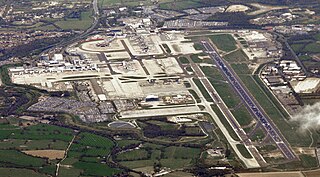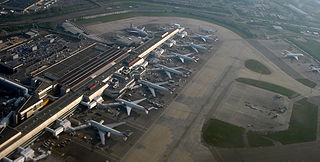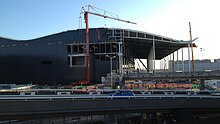British Airways plc (BA) is the flag carrier airline of the United Kingdom. It is headquartered in London, England, near its main hub at Heathrow Airport.

Heathrow Airport, called London Airport until 1966, is the main international airport serving London, the capital of England and the United Kingdom. It is the largest of the six international airports in the London airport system. The airport is owned and operated by Heathrow Airport Holdings, owned mostly by Ferrovial, Qatar Investment Authority and CDPQ. In 2022, it was the second-busiest airport in the world by international passenger traffic and the busiest airport in Europe in 2023. It is also the airport with the world's most international connections as of 2023.

London Stansted Airport is the tertiary international airport serving London, England. It is located near Stansted Mountfitchet, Essex, 42 mi (68 km) northeast of Central London.
Virgin Atlantic, a trading name of Virgin Atlantic Airways Limited and Virgin Atlantic International Limited, is a British airline with its head office in Crawley, West Sussex, England. The airline was established in 1984 as British Atlantic Airways, and was originally planned by its co-founders Randolph Fields and Alan Hellary to fly between London and the Falkland Islands. Soon after changing the name to Virgin Atlantic Airways, Fields sold his shares in the company after disagreements with Richard Branson over the management of the company. The maiden flight from London–Gatwick to Newark took place on 22 June 1984.

John F. Kennedy International Airport is a major international airport serving New York City, United States. The airport is the busiest of the seven airports in the New York airport system, the 6th-busiest airport in the United States, and the busiest international air passenger gateway into North America. The facility covers 5,200 acres (2,104 ha) and is the largest and busiest airport in the New York City area.

London Gatwick, also known as Gatwick Airport, is the secondary international airport serving London, England, United Kingdom. It is located near Crawley, West Sussex, England 29.5 miles (47.5 km) south of Central London. In 2022, Gatwick was the second-busiest airport by total passenger traffic in the UK, after Heathrow Airport, and was the 8th-busiest in Europe by total passenger traffic. It covers a total area of 674 hectares.

Paris Charles de Gaulle Airport, also known as Roissy Airport or simply Paris CDG, is the main international airport serving Paris, France. Opened in 1974, it is in Roissy-en-France, 23 km (14 mi) northeast of Paris and is named after World War II statesman Charles de Gaulle (1890–1970), whose initials (CDG) are used as its IATA airport code.

San José Mineta International Airport, officially Norman Y. Mineta San Jose International Airport, is a city-owned public airport in San Jose, California. Located 3 miles (4.8 km) northwest of Downtown San Jose, the airport serves both the city and the Santa Clara Valley region of the greater San Francisco Bay Area. It is named after San Jose native Norman Mineta, former United States Secretary of Transportation and United States Secretary of Commerce, who also served as Mayor of San Jose and as a San Jose City Councilman.

Manchester Airport is an international airport in Ringway, Manchester, England, 7 miles (11 km) south-west of Manchester city centre. In 2022, it was the third busiest airport in the United Kingdom in terms of passengers and the 19th busiest airport in Europe in 2023, with 28.1 million passengers served.

Glasgow Airport, also known as Glasgow International Airport, formerly Abbotsinch Airport, is an international airport in Scotland. It is located in Paisley, Renfrewshire, 8.6 nautical miles west of Glasgow city centre. In 2019, the airport handled 8.84 million passengers, an 8.4% annual decrease, making it the second-busiest in Scotland, after Edinburgh Airport, and the ninth-busiest airport in the United Kingdom.

Southampton Airport is an international airport located in both Eastleigh and Southampton, Hampshire, in the United Kingdom. The airport is located 3.5 nautical miles north-north-east of central Southampton. The southern tip of the runway lies within the Southampton unitary authority boundary with most of the airport, including all of the terminal buildings, within the Borough of Eastleigh.

Inverness Airport is an international airport situated at Dalcross, 7 NM north-east of the city of Inverness, Scotland. It is owned by Highlands and Islands Airports Limited (HIAL). The airport is the main gateway for travellers to Inverness and the North of Scotland with a range of scheduled services throughout the United Kingdom, and various scheduled services to Continental Europe. Charter and freight flights operate throughout the UK and Europe. Latest figures state 946,391 passengers passed through the airport in 2019. The airport is also headquarters to Dalcross Handling which now operates across Scotland.

Heathrow Terminal 5 is an airport terminal at Heathrow Airport, the main airport serving London. Opened in 2008, the main building in the complex is the largest free-standing structure in the United Kingdom. Until 2012 the terminal was used solely by British Airways. It was then exclusively used as one of the three global hubs of IAG, served by British Airways and Iberia until 12 July 2022, when Iberia moved all flights to Terminal 3, leaving British Airways as sole user again.

Heathrow Terminal 4 is an airport terminal at Heathrow Airport, the main airport serving London, England, situated to the south of the southern runway, next to the cargo terminal. It is connected to Heathrow Terminals 2 and 3 by the vehicular Heathrow Cargo Tunnel, and by rail with the Heathrow Terminal 4 tube and Heathrow Terminal 4 railway stations. Built at a cost of £200 million, Terminal 4 was opened by the Prince and Princess of Wales on 1 April 1986. British Airways was the main airline operating from the terminal from 1986 until its move to Terminal 5 on 29 October 2009, eventually making Terminal 4 the Heathrow base for airlines of the SkyTeam airline alliance.

Heathrow Terminal 3 is an airport terminal at Heathrow Airport, serving London, the capital city of the United Kingdom. Terminal 3 is currently used as one of the main global hubs of the International Airlines Group members British Airways and Iberia since 12 July 2022. It is also used by the majority of members of the Oneworld and a few SkyTeam alliances along with several long-haul non-affiliated airlines. It is also the base for Virgin Atlantic.

Heathrow Terminal 1 is a disused airport terminal at London Heathrow Airport that was in operation between 1968 and 2015. When it was officially opened by Queen Elizabeth II in April 1969, it was the largest new airport terminal in western Europe. At the time of its closure on 29 June 2015 to make way for the expansion of Heathrow Terminal 2 it had been handling only twenty daily flights by British Airways to nine destinations. From May 2017 the contents of the terminal were put up for auction.
In its early years what is now Heathrow Airport was the Great West Aerodrome, sometimes known as Heathrow Aerodrome.

The West London Air Terminal was a check-in facility for British European Airways flights from Heathrow Airport. It was located on Cromwell Road in Kensington, London, and was in operation from 6 October 1957 to 1 January 1974. After passengers checked in their baggage and received their boarding passes, they would travel to Heathrow Airport by coach. One of the drawbacks of using the terminal for checking in was that road traffic could delay the coaches and ultimately delay the departure of the flight.
Gatwick Airport was in Surrey until 1974, when it became part of West Sussex as a result of a county boundary change. The original, pre-World War II airport was built on the site of a manor in the parish of Charlwood. The land was first used as an aerodrome in the 1920s, and in 1933 commercial flights there were approved by the Air Ministry.

Los Angeles International Airport has more than 150 gates in nine passenger terminals arranged in the shape of the letter U or a horseshoe. On the landside of the airport, LAX Shuttle route A buses allow passengers to move between all terminals. On the airside, various pedestrian corridors allow passengers to move between all terminals on foot without having to exit and reenter airport security. Additionally, by early 2025, the airport will be served by the LAX Automated People Mover, which will connect terminals to one another on the landside, along with providing connections to the LAX Consolidated Rent-A-Car Facility, parking facilities, and the LAX/Metro Transit Center station, which will be served by the Los Angeles Metro Rail system and public bus routes. In addition to these terminals, there are 2 million square feet (190,000 m2) of cargo facilities.






















